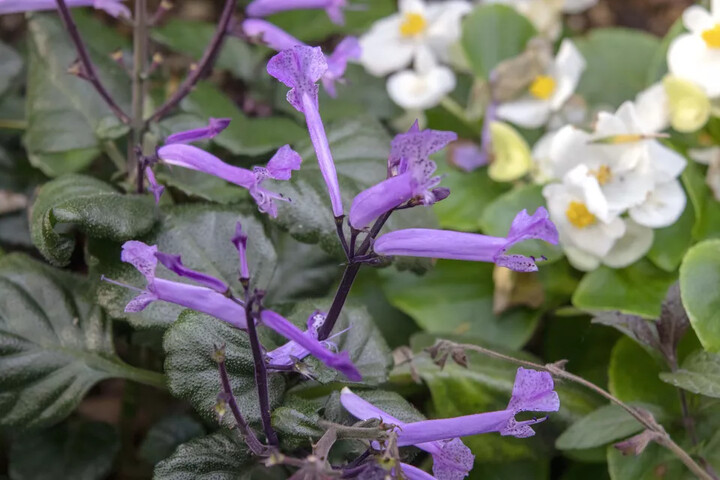The Mona Lavender (a species from the genus plectranthus) is the ideal houseplant for anyone who loves the color purple. Unlike many other members of its genus, this lovely hybrid is primarily grown for its attractive lavender flowers, which will appear throughout a long bloom period.
A tropical, hardy little plant related to Swedish ivy, mint, and Creeping Charlie (the notorious lawn weed), this purple charmer is easy to grow (even for those without a green thumb) and will thrive with minimal care. It's named for the Greek words “plectron,” which means spur, and “anthos,” which means flower.
A type of spurflower, this plant belongs to a group that includes plants from Asia, Africa, and Australia. The Mona Lavender is native to South Africa, where it was first developed at the Kirstenbosch Botanical Garden in Cape Town in the late 1990s as a hybrid from stoep spurflower (Plectranthus saccatus) and candle plant (Plectranthus hilliardiae). It displays the parental traits of both plants, which is why it's known for its vibrant leaves and large lavender blossoms.

The Mona Lavender's pretty purple blooms will open on a spike that juts out above its leaves; small flowers will grow on stalk flowers and attract an array of pollinators.
Botanical Name:
Plectranthus Mona Lavender
Common Name:
Mona Lavender
Plant Type:
Perennial
Mature Size:
1-2 feet
Sun Exposure:
Part shade
Soil Type:
Well-drained, slightly acidic
Soil pH:
5.6-6.5
Bloom Time:
Fall-Spring
Flower Color:
Purple
Hardiness Zones:
9-11
Native Area:
South Africa
Mona Lavender Care
The best feature of this perennial is how easy it is to grow both indoors and outdoors. Considered to be a short day plant, it will shift into its flowering mode as days become shorter and its growth will taper off as temperatures get warmer and days get longer. If you happen to live in a region with mild winter temperatures, you can expect your plants to flower on a consistent, steady basis from fall all the way through spring.
The Mona Lavender will bring beauty to your garden year-round as its flowers even continue to bloom in the winter months. However, it makes for an attractive plant whether it's in bloom or not.
Better yet, it thrives indoors as a houseplant and also makes for a no-fuss shrubby perennial when planted outdoors. Just keep in mind that the light will determine both its leaf and flower color--the brighter the light, the richer its color becomes.
Light
A spot that receives bright, indirect light is ideal for this perennial. You'll also want to be sure it's planted in a location that receives morning sun.
Soil
When choosing a soil, opt for a well-drained, slightly-acidic variety containing organic matter.
Water
The Mona lavender will grow best when provided with both regular and even moisture. It's considered a "thirsty" plant and should be watered every few days.
Temperature and Humidity
Though this plant will grow in year-round temperatures of 60 to 80 Fahrenheit, the Mona Lavender is also considered to be winter hardy since it can withstand light frosts and temperatures down to 25 or 30 degrees Fahrenheit.
Fertilizer
The Mona Lavender can be fertilized every six to ten weeks; just be sure to choose a water-soluble variety.
Propagating Mona Lavender
When pruning your Mona Lavender plant, hang on to its cuttings--they root easily in water and can be replanted in pots.
Similar Varieties of Plectranthus
Troy's Gold (Plectranthus ciliatus)
Coleus (Plectranthus scutellarioides)
Silver Shield (Plectranthus argentatus)
Vick's Plant (Plectranthus tomentosa)
Growing in Containers
In containers, be sure to choose a soilless medium designed for use in pots. When grown indoors, the Mona Lavender will do best in a spot near either a bright east or south window.
When temperatures rise above freezing in the late spring, you can shift your plant outside for the summer. Just be sure to do your best to protect your Mona Lavender from the afternoon sun, as this is a plant that can not thrive in the hottest months of the year.
Pruning
Though this plant doesn't require a significant amount of pruning, you can pinch young Mona Lavenders regularly to help encourage branching and the growth of fuller, bushier plants. Long-growing stems can also be snipped.
You'll want to consider trimming off new stem tips on a regular basis to help the plant retain its compact shape and form, as well as removing the flower spikes after blooming.